“Team Ned” consisting of James Brooks, Laurelyn Sayah, and myself, just returned from a great adventure in the stark Atacama desert of Southern Peru.
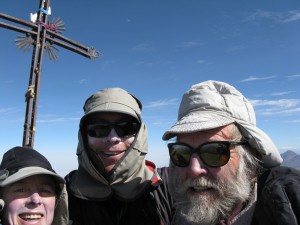
Team Ned on the summit of Volcan Misty 19,101ft. This was our practice climb to get used to the altitude.


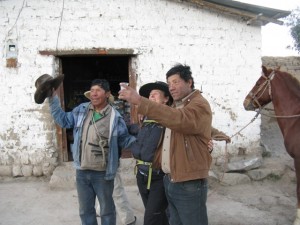
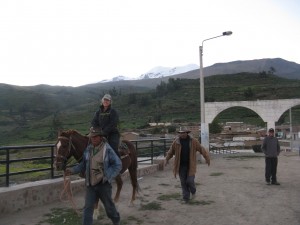


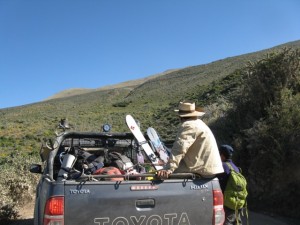
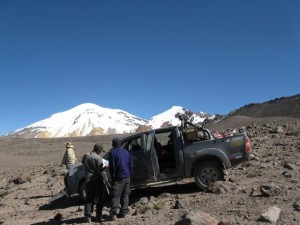
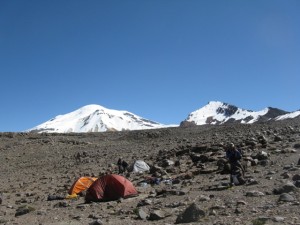
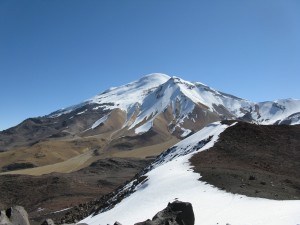


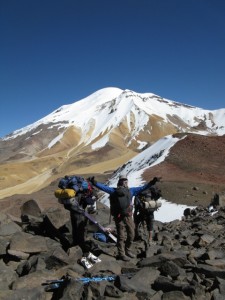


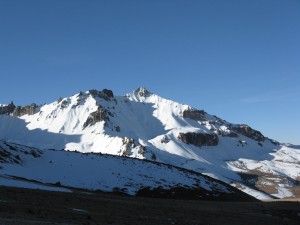
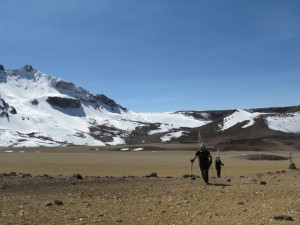

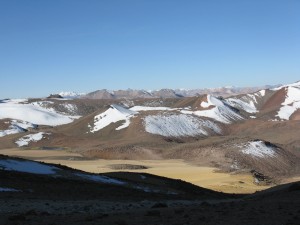

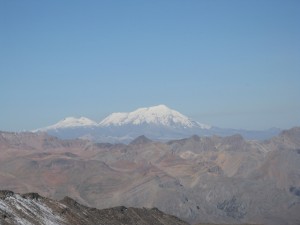
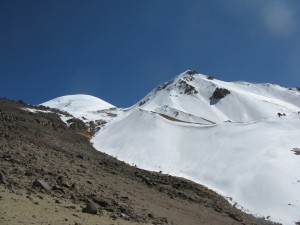


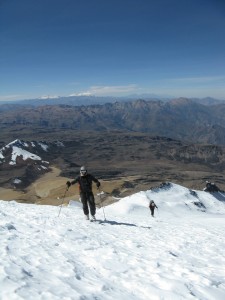
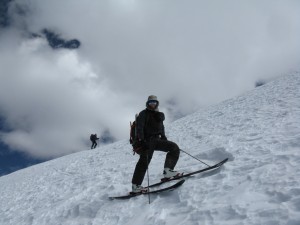
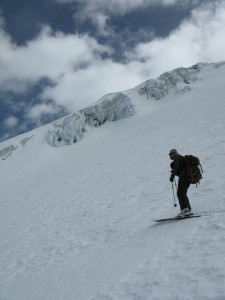
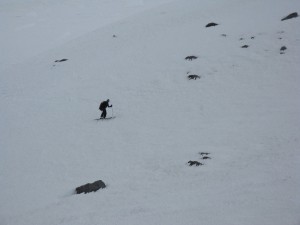
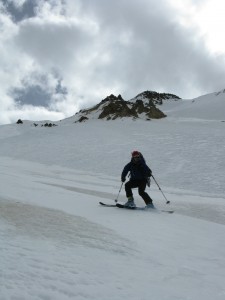
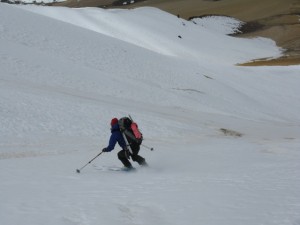
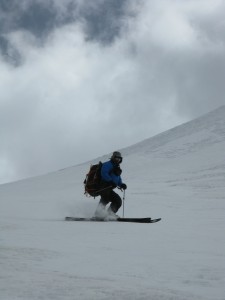
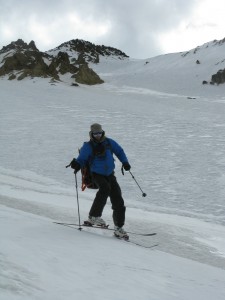



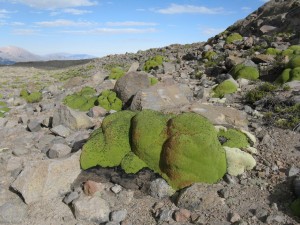
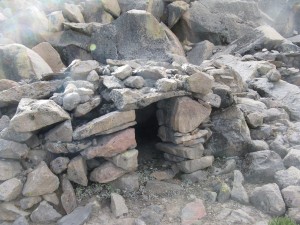


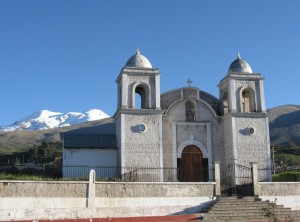
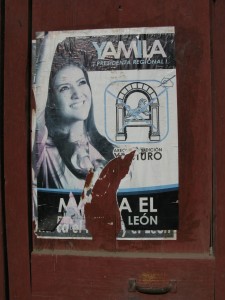
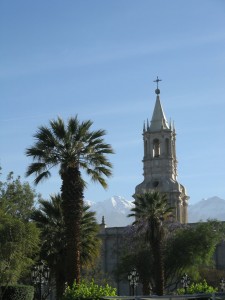 Nevado Coropuna is a large and very complex old volcano that has at least six; 20,000 foot plus summits. The true summit is 21,079, which makes it the highest volcano in Peru, and it is considered extremely sacred by the native inhabitants of it’s many valleys.
Nevado Coropuna is a large and very complex old volcano that has at least six; 20,000 foot plus summits. The true summit is 21,079, which makes it the highest volcano in Peru, and it is considered extremely sacred by the native inhabitants of it’s many valleys.
Unlike the sacred spires of the Navajo in Arizona, (where climbing is forbidden) the natives believe that climbing this mountain will bring good luck and a long life. Ancient mummies have been found near the summit, so it is easy to assume that the first ascent was achieved by the Incas.
The easiest route to the summit is a friendly low angle glacier, and the weather is excellent, so this could have been accomplished by strong warriors without modern gear, and I’ll bet that it was an awesome adventure.
This Majestic old volcano sits in a magical spot between the two deepest canyons in the world, and it’s ancient eruptions have been a major force in forming the unique geology of the region. I caught a glimpse of this grand peak on a previous kayaking expedition, and the image has lingered in my impressionable mind.
Kayaking the infamous Colca canyon, and the nearby Cotahuasi had been two of my greatest journeys, so the giant mountain that stood between them was incredibly enticing.
My good friend James and I had been hoping to climb and ski a 20,000 foot peak for quite some time, and this looked like the perfect choice. Our friend Laurelyn, who is a very strong climber and skier was thinking about joining us, so we planned a one day backcountry ski adventure at a local peak.
We were all strong skiers, but this would test our compatibility and team attitude. It was an awesome day of skiing and camaraderie, and Laurelyn bought a ticket while we were sitting in her friends hot tub.
After a quick day of eating gormet food by the ocean and finding a map, we left Lima at dawn and flew over the vast expanse of the Atacama desert. The flight pattern was a bit different than what I had imagined, so I was extremely elated when a giant old volcano appeared below us.
“James! Laurelyn! Check this out!” I exclaimed from my window seat. “That is definitely Coropuna! Wow! Doesn’t it look great!”
We already new that it was massive mountain, but the areal view was astounding. Team Ned reacted with giant smiles as the thrill of a new adventure became a reality.
My friend Lillian was waiting patiently at the airport and rushed us to a pleasant old hostel with great views of the nearby mountains and an elegant courtyard.
James was on a tight schedule between geology jobs and we needed to get used to the altitude, so Lillian’s driver returned in a few hours and drove us as high as we could go in the local neighborhood.
21,000 feet sounds really high to the average novice, and it is quite high, but proper preperation can make it quite reasonable. It does involve a bit of suffering, but that makes the reward evan greater.
Everyone on the team had been to a similar altitude previously, and we all new the rules. “Climb high and sleep low.”
The majestic old city of Arequipa sits at 8,200 feet in the lush valley of the Chili river, and might be the perfect base camp. It offeres all the amenities of a grand old city, and the close proximity of some very big mountains.
The taxi driver didn’t go quite as high as we desired, but we enjoyed a very pleasant hike on the flanks of Vulcan Misti (19,101) which towers above the ancient city.
The trail was empty, and the high desert botany was blooming. The scenery on this old volcano was stunning, and It was hard to believe that we were only a few miles from the second largest city in Peru.
This short hike was intended to shock our brain to get ready for what was forthcoming, and we rushed back down to a fine dinner of Ricotto rellanas and Pisco Sours.
The next day was spent resting and trying to find camp stove gas and a few staples for the next phase of our expedition.
Arequipa is not very famous for mountaineering and finding gas for our stove proved to be very challenging, so we opted for a cold breakfast at 4 AM. Laurelyn voted against this extreme tactic, but she was outnumbered by the guys.
The South Face of Misti is a classic route that involves some steep rock scrambling and a bit of ice.
Water is a big challenge on the desert mountains, so we hired two porters to help with the journey to base camp. The trail started at about 13,000 and involved climbing along a very scenic volcanic ridge. Our porters complained about the amount of water we were bringing, but it was the perfect amount for us. (One of the biggest rules for high altitude is lots of water.
Reaching our high camp of about 15,500 was easier than we had expected, and we enjoyed the vistas of the nearby mountains and the disappearing lights of the old metropolis.
Our porters were apprentice guides who had climbed this mountain many times. They showed us the best route, but seemed very content to sleep in and spend the day discussing their lives and the grand problems of the world.
Getting up before dawn can be a bit harsh, but the big mountains demand this loyalty and the rewards are grand. The busy planet is empty, and a new day is waiting.
“It’s 4 O’clock!” I exclaimed! as I awoke from my very light slumber.
One of he biggest challenges of climbing high is sleep, and we were camped at about 15,500. The stars were quite good, but the night was long so I managed to get only a small amount of rest as I anxiously awaited the dawn.
After a quick breakfast of power bars, we headed upward on a faint trail through the debris of the ancient eruptions with our headlamps. Most of the trail was quite pleasant, and we watched in awe as the morning sun marked the shadow of the old volcano on the ancient city.
The altitude was challenging, but we all survived and arrived at the edge of the old cauldren just after dawn. The summit was still about a half an hour away, but we stopped to absorb the sun and the magnificent views.
The brief rest gave us new energy, and we charged up the somewhat challenging snow to the summit.
Summits are always a bit magical, but this one was memorable. An old metal cross graced the peak and the views were stunning. The short cut down through the cinders, that our porters had advised provided a few icy challenges. But this quickly eased, and sliding down the untracked cinders was fun and easy. A quick phone call alerted our taxi, and he was waiting at the trailhead with cold beer. A fine dinner and comfortable beds were waiting patiently in Arequipa, so we rushed back to the big city. We were all quite exhausted, but no one had a headache or any other serious symptoms, so we felt ready for the big mountain.
I was sleeping about 3 seconds after my head hit the pillow, and awoke to another perfect day.
Our original intention was to ski a route on the south face that Mike and Steve Marolt from Aspen had done a few years before, but the fickle finger of fate intervened. The burros that we were attempting to hire in the small village of Viraco were looking quite problematic, when our fearless porters found a local with a solid 4-wheel drive pickup. He told us there was a primitive road that would take us very close to where we wanted to go, and he was cheaper than the burros so we quickly loaded our gear.
The last section of the road involved careful route finding through a maze of boulders in the stark and very remote Atacama desert. An old set of tire tracks was barely visible, and a few cairns helped to mark the path. But, our fearless driver prevailed and drove us to a small lake at about 16,500 feet. The lake was a very welcome surprise, and we quickly set up camp.
The truck ride was a lot easier than hiking behind burros, and the day was still young, so we spent the rest of it scouting out the route and carrying some of our gear toward the next camp. It was obvious that we were on a different side of the mountain than what the Marolts had skied, but the route looked reasonable, and the approach looked easier than what we had expected.
“Team Ned” would be attempting to climb and ski what we thought was a new route on the South East face of the 3rd highest summit, which is about 20,800 feet.
We returned to camp in time for an hour of warm sunshine and a brilliant sunset, but the days on the equator are short, and the sun goes down very quickly. The day had been quite toasty, but the heat vanished at sunset, so we climbed into our warm bags and enjoyed the best stars that I have ever witnessed. It was a new moon, and the dark skies combined with the thin air provided a stunning spectacle of millions of stars and constellations that few people had ever seen.
I watched in awe as a brilliant sunrise lit up the grand face of Coropuna and a long string of the adjacent mountains. The early morning light on the plume of smoke billowing from Volcan Sabancaya was brilliant, and evoked intense emotions of our encounter with this stark paradise.
The sun quickly warmed our camp, and our spirits soared as we prepared to move higher.
The spot where we had left our stash of gear revealed a short ski run, so we left our skis and ventured upward to camp 2 with half of the load. Water is a huge challenge on most of the desert mountains, so we were elated when Juan and Bryon (our porters) found a pristine lake.
We had been planning to melt snow but the challenges of finding fuel in Arequipa had left us a bit short, so this was a huge find. This incredible lagoon was at about 17,000 feet and was not shown on our map. It appeared to be very deep and the water was clear and clean. A small flock of ducks swam calmly in the still waters and the glaciated faces of the nearby mountains towered above it. It was one of the best camps that I’ve ever experienced, and we savored the beauty for a few moments before returning to our skis.
The snowy face was only about 400 vertical feet, but it would give us a chance to test the conditions, and the alternate route to camp 2 looked about equal. The skiing was a lot better than we had expected, and our moods suddenly soared to euphoria as we finished the short run and followed the stark and empty volcanic valley back to our new camp.
The lake seemed to warm the air a bit, but the
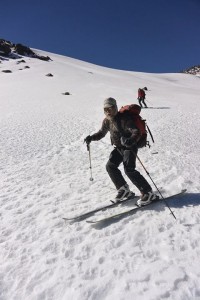



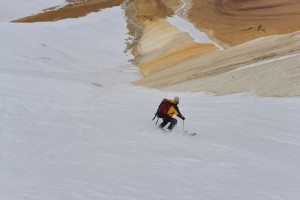
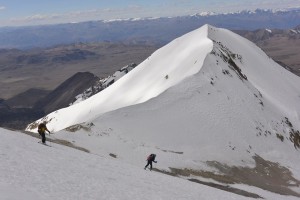
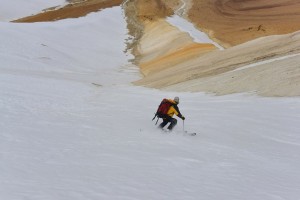
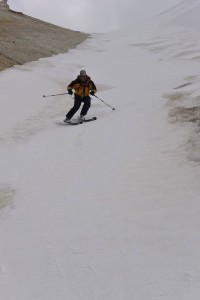 frost was very dense in the morning. The changing light on the face that we were hoping to climb revealed an ice fall and a few crevasses, but we thought we saw a safe route. It is really hard to judge the steepness of a face from a direct view, but it looked quite reasonable, so we moved our camp up to about 17,500 and prepared for the big day.
frost was very dense in the morning. The changing light on the face that we were hoping to climb revealed an ice fall and a few crevasses, but we thought we saw a safe route. It is really hard to judge the steepness of a face from a direct view, but it looked quite reasonable, so we moved our camp up to about 17,500 and prepared for the big day.
The high altitude air was brisk, but we started early and watched the dawn awaken in the harsh and magical desert. A quick break revealed the stunning scenery of the nearby Colca Canyon and the majestic volcanoes that tower above it.
The snow softened very quickly in the warm sun, so we switched to skis and continued upward. This method involved attaching synthetic fur “skins” to the bottom of our skis. This allows the skier to glide forward and grip backwards and is a great way to climb a snowy mountain. The “snow” now consisted of a mixture of frozen and partially melted penitentes that would be challenging to ski, but the pitch was less than we had expected, and we moved steadily onward.
We had studied the face as much as we could from our camp, and we could now get a better look at two options. Going left of the icefall looked crevasse free, but it would involve climbing about 150 feet of fairly steep (approximately 60 degree) snow. Our map showed low angle slopes on the other side, but it did not show the steep wall of snow, so we didn’t really trust it. This would also not be a direct route, which made it less enticing. The route to the right was lower angle, and the crevasses looked minimal from our viewpoint, so we headed right. The skinning got quite challenging as we encountered steeper slopes and a few patches of ice, but we trudged onward past the icefall and stopped to regroup when we reached a band of crevasses.
The area of crevasses was quite wide and appeared to be a lot more dangerous than it had looked from below. The slope was getting too steep to skin and the snow was too soft for walking, so we enjoyed the view and discussed our options. We had come prepared with a rope and snow pickets, but crossing the bridges of snow on the band of crevasses would involve some serious route finding and would be very dangerous without skis.
We had already reached an altitude of about 20,400 feet, and the summit was only 400 feet away, but the day was waning and the ski descent would be a daunting challenge. It was hard to turn around when we were so close to the summit, but we all agreed that it was time to retreat. Our main goal was to ski from 20,000 feet and this could already be accomplished, so we enjoyed the astonishing view and prepared for the descent.
The first few turns were quite challenging, with a mixture of frozen and melted penitentes, along with a few smooth sheets of ice, but the conditions gradually improved, and the soft penitentes skied reasonably well. The snow softened as we lost altitude, but a rare cloud was moving in, and a change of aspect provided the biggest challenge of the expedition. Our team was suddenly faced with about 500 vertical feet of frozen penitentes, which we all agreed was the most challenging snow we had ever skied. But there was an escape route, and a long traverse to a south facing slope provided icy, but smooth conditions. This led us back to a very pleasant 1200 foot 35 degree slope that ended about 100 yards from our tents.
After another night of basking in the starlight, we retreated back to camp 1 and enjoyed a late afternoon hike to a primitive ancient ruin, and an old Inca road. Our loyal porters had wandered the hillside in search of a cell phone signal, and our faithful driver had agreed to work a second shift.
We savored the sunset and the end of a great expedition, but we were still in the very middle of nowhere, and a bit anxious about wether he could find us again in the dark. Our food was nearly gone, and we were almost out of fuel, but we managed to cook a fine dinner, and waited anxiously in the cold darkness. This harsh desert seemed to be totally void of anything combustible, but Juan found the skeleton of a local plant and managed to build a small fire. This ancient plant called Yareta resembles a pile of rocks covered with lichen. The local people use it for many of their herbal medicines, and it is considered to be a sacred plant. We had curiously observed it and assumed that it was lichen, and didn’t realize it’s true identity until Juan and Bryon built the fire. The small flame helped to warm the bitter cold air, but we were elated to see the 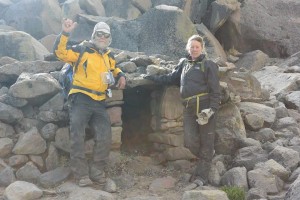 headlights of our fearless driver, as he miraculously wound his way through the maze of rocks in the dark. Our weary crew quickly loaded all the gear and we bounced down the seemingly endless road to a comfortable hostel in Viraco.
headlights of our fearless driver, as he miraculously wound his way through the maze of rocks in the dark. Our weary crew quickly loaded all the gear and we bounced down the seemingly endless road to a comfortable hostel in Viraco.
A pleasant, sunny morning was spent roaming the ancient streets, and another scenic ride brought us back to the alluring old colonial city of Arequipa.
Our hostel manager was excited to see us, and we enjoyed a fine dinner of Ricotto Rellenas and Pisco Sours. A lifetime of adventures.
